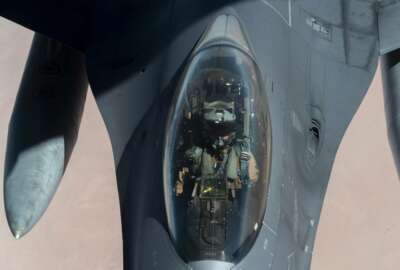

Defense Secretary Lloyd Austin signed the strategy on May 13, officials said Friday. They said the classified document would add teeth to DoD's efforts to...
Defense Secretary Lloyd Austin has signed the department’s first-ever comprehensive strategy for Joint All-Domain Command and Control (JADC2), DoD’s sweeping effort to digitally interconnect its weapons systems and sensors.
Defense officials told reporters at the Pentagon that Austin signed the document on May 13. The strategy itself is classified, but the department is working on an unclassified summary for public consumption that’s “nearly finished,” said Lt. Gen. Dennis Crall, the Joint Staff’s director for command, control, communications and computers (J-6).
Although the basic JADC2 framework is not new, Crall said the secretary’s imprimatur on a formal strategy document would add clearer governance and direction to the experimentation work already being conducted by the military services, including in the Army’s Project Convergence, the Air Force’s Advanced Battle Management System and the Navy’s Project Overmatch.
“[Until now] I could persuade individuals to adhere to a framework and a structure, but if there was slow compliance or no compliance, there was really no teeth in the system to make that change — we had no Northern Star,” he said. “What this does is allows me to take the JADC2 strategy and a specific line of effort and place it directly over the top of this experimentation and vet it, and see what parts of are in compliance today in which parts are not. And the pieces that are not, what do we want to do with them? Do we break them off into smaller experiments because they still may be pointing to something, or do I recapitalize that money and put it somewhere else?”
The JADC2 concept aims to not only interconnect all of the military’s weapons systems, but to layer in advanced technologies like machine learning, artificial intelligence and predictive analytics. Of the three military departments, the Air Force is perhaps the furthest along in its experimentation.
Last month, officials said they were ready to move the project from a purely theoretical phase to one where it will now be buying hardware and software to deploy aboard real-world weapons systems, starting with new data “pods” to be installed on the service’s KC-46 refueling tanker.
Crall said the forthcoming unclassified version of the strategy would be “substantive,” and give the public and industry a clear view of where the department’s initial priorities lie.
“We have to set some things right in the department, and the first one is the definition of a federated data fabric,” he said. “We’ve had several data summits, and we’re going to have another one in about a week, where we’re pulling the community together to define what this looks like. It’s a balance of tolerances: If you set it too open, you don’t have a standard. If you set it too narrow, it’s too prescriptive. There is something in the middle that fits, and that’s what we’re in search of.”
Crall said other priorities would be devising an identity management solution for JADC2 and institutionalizing agile software development.
“[We need] professionally developed, nimble, containerized, upgradable software, versus software that is locked, almost impossible to change, and can’t be adapted again in those areas of the fight we expect to be,” he said.
A DoD-wide cloud computing platform — one with capabilities that can be extended to the tactical edge – will also be critical to JADC2’s success, whether that enterprise cloud is JEDI or different eventual product, Crall said. But he said the department has access to enough commercial cloud capabilities via other contracts for its current JADC2 needs.
“I think the real question would be how long can you do that, and when do you run out of resources?” he said. “Not all clouds have the characteristics that we’d need to survive on that tactical edge. So where we sit today, I can get the work done. But the delivery of JADC2 is dependent on a robust, purpose-built cloud for the environment that we need to operate in.”
Copyright © 2025 Federal News Network. All rights reserved. This website is not intended for users located within the European Economic Area.
Jared Serbu is deputy editor of Federal News Network and reports on the Defense Department’s contracting, legislative, workforce and IT issues.
Follow @jserbuWFED


